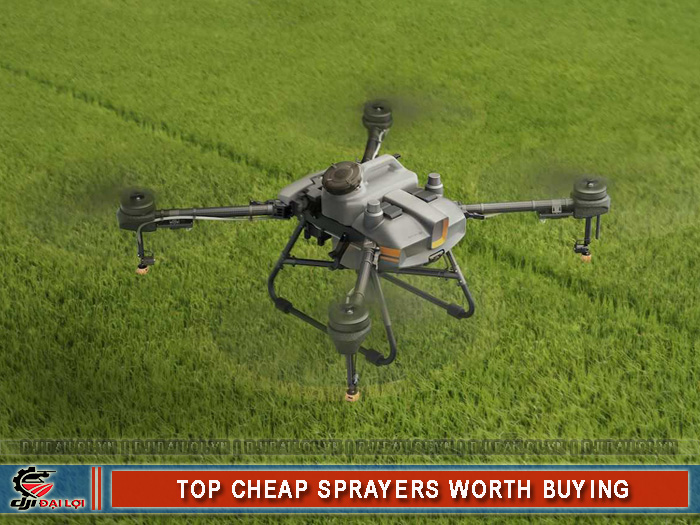
In recent years, affordable crop-spraying drones have become an integral part of smart farming. The use of UAVs allows farmers to spray pesticides and fertilizers several times faster than manual methods, saving labor and reducing chemical exposure.
Models from DJI Agras, XAG, and PG series continue to evolve with radar obstacle detection, GPS RTK navigation, and automated spraying routes, giving Vietnamese farmers access to advanced technology at increasingly lower costs.
Their popularity stems from fast ROI, low operating costs, and high flexibility. With prices ranging from 70–100 million VND, a drone can replace 10–15 manual workers per day. Modern electric drones are quiet, easy to maintain, and well-suited for small and medium-sized farms.
Drone prices depend on:
Notably, localized or Chinese-manufactured versions offer competitive performance at lower costs, making them ideal for Vietnam’s agricultural needs.
Choose drone capacity according to the cultivated area:
Matching the right tank size ensures cost efficiency and optimal spraying output.
|
Criteria |
Electric Spraying Drone |
Gasoline Spraying Drone |
|---|---|---|
|
Operating cost |
Low – rechargeable battery |
Higher fuel cost |
|
Maintenance |
Simple |
More complex |
|
Spraying performance |
Stable, low noise |
Stronger, suited for large fields |
|
Environmental impact |
High (eco-friendly) |
Moderate |
→ For most farmers, affordable electric drones remain the optimal choice due to low running costs and easy maintenance.
2025 models come equipped with dual radar, obstacle detection, and GPS RTK mapping, enabling precise, automated spraying paths with minimal overlap - saving chemicals and ensuring even coverage across large fields.
Always prioritize drones with at least a 12-month warranty and readily available replacement parts (batteries, nozzles, propellers). Major brands like DJI and XAG have official distributors in Vietnam, ensuring reliable maintenance and technical support.
The DJI Agras T20P delivers exceptional spraying precision with dual radar and RTK navigation. Its 20-liter tank covers 6–8 hectares per hour, making it ideal for small and medium farms. Priced around 90 million VND, it offers outstanding value and reliability.
The T30’s 30-liter tank and fine mist system save up to 25% in pesticide use. Popular in the Mekong Delta, it handles wind effectively and maintains even coverage. At roughly 120 million VND, it’s one of the best price-to-performance options.
Built with an ultra-light carbon fiber frame, the XAG P100 offers exceptional stability even in strong winds. Its removable battery and auto-mapping spraying system make it ideal for cooperatives managing 20–30 hectares.
The PG40 stands out among drones under 100 million VND for its compact design and easy maintenance. Its 18,000 mAh battery allows 15–20 minutes of continuous flight per charge - ideal for small farms or fruit orchards.
Vietnamese startups such as DJI Đại Lợi, AgriDrone, and SkyAgro have launched models priced from 60–80 million VND. They use imported motors but are locally assembled to reduce costs while maintaining durability.
Most affordable drones can spray 4–10 hectares per hour, depending on tank size and motor power. Dual-rotor designs improve downward airflow, ensuring better leaf coverage and reducing drift losses.
Smart pressure sensors help regulate spray output evenly. Each flight lasts 10–15 minutes, using about 2–3 liters of solution per hectare, saving up to 30% pesticide compared to manual spraying.
Modern budget drones meet IP67 standards, offering dust and light water resistance. Motors, pumps, and propellers are well-sealed for stable operation in humid or windy environments typical of Vietnam’s rice and fruit farms.
A single affordable spraying drone can replace up to 10 manual workers, cutting labor and fuel costs. Farmers typically recover their investment within 1–2 crop seasons.
Modern radar and sensors automatically adjust altitude and spray rate based on crop type and wind speed - suitable for rice, mango, coffee, and citrus - reducing waste and preventing leaf burn.
Regular, uniform spraying promotes healthier crops and higher yields - increasing productivity by 10–15% per season. For cooperatives, this translates to sustainable long-term profit.
Buy from authorized dealers officially certified by DJI, XAG, or PG. These stores should provide on-site maintenance and technical support. Avoid unverified social media sellers.
Check for:
Authentic models will have matching serial numbers with the manufacturer’s database.
Reputable distributors like Đại Lợi Drone and AgriDrone Vietnam offer training, software updates, and free scheduled maintenance - crucial for ensuring long-term stability.
These models deliver the best balance of investment cost, spraying efficiency, and durability.
Before purchasing, calculate your farm area, crop type, and spraying frequency. Choose suppliers with strong after-sales service. Investing in a high-quality budget drone is a sustainable step toward smarter, more efficient Vietnamese agriculture.
Affordable spraying drones are not just a trend - they’re a practical, cost-effective tool driving Vietnam’s farming modernization and productivity growth.
Yes. With proper maintenance, models like DJI or XAG can operate reliably for 3–5 years thanks to carbon frames and brushless motors.
Only if it still has a valid warranty, fewer than 200 battery cycles, and a stable motor. Avoid clearance sales with unclear origins.
Most models perform well on rice, corn, coffee, and fruit trees, and can adjust spray volume for wider canopies like mango, citrus, or pomelo.
In Vietnam, small-scale farmers only need to register their drones for personal use - no commercial license required, but flight safety near residential areas must be observed.
At the start of the crop season, allowing full use throughout spraying cycles and ensuring a faster return on investment.